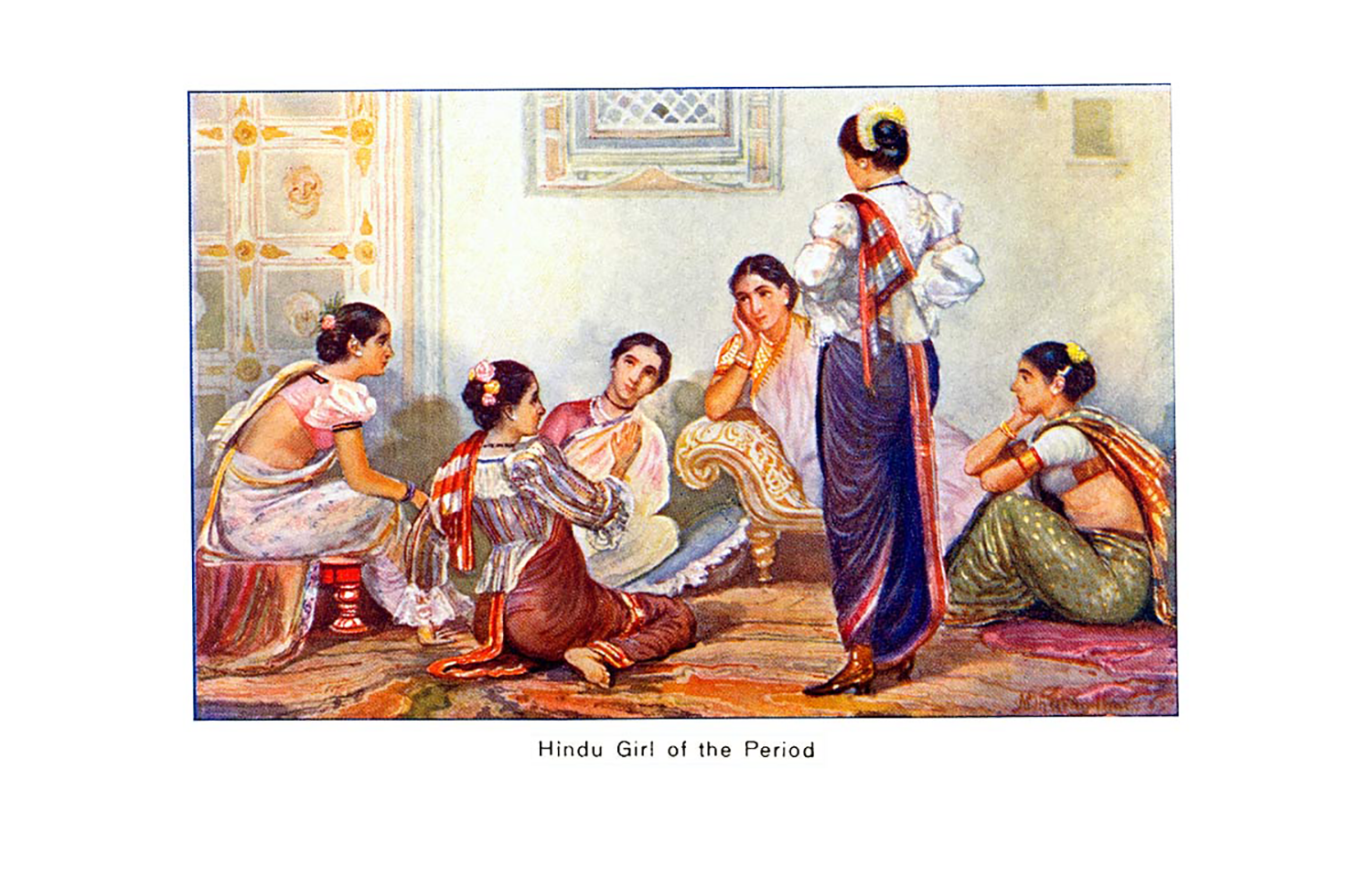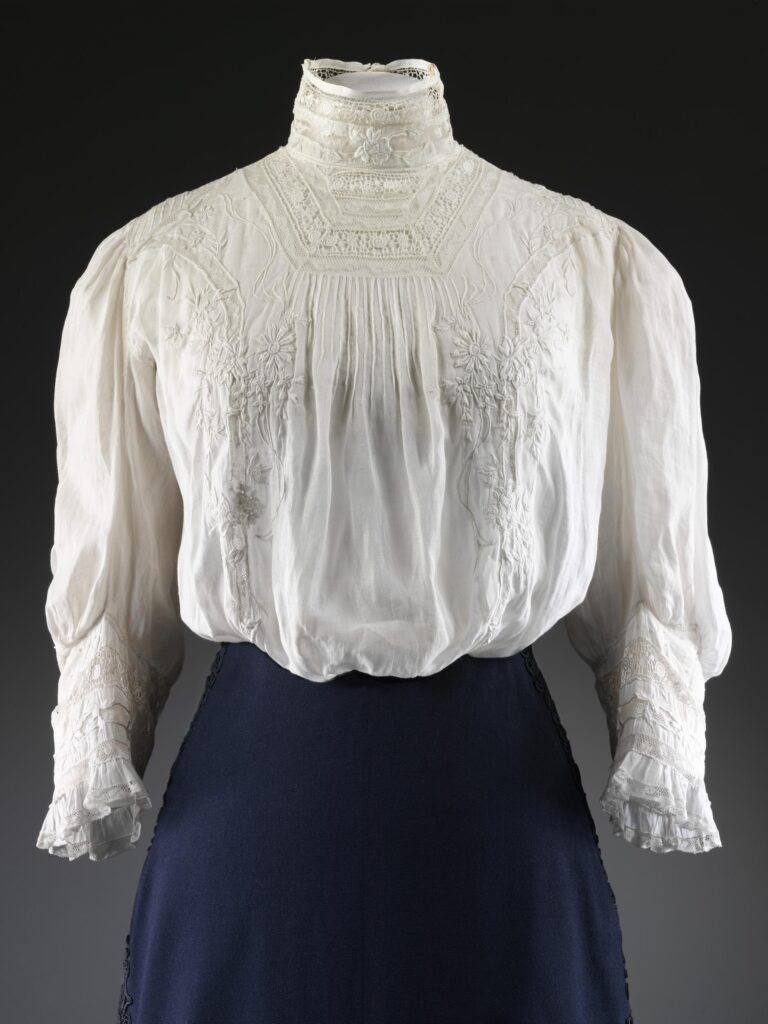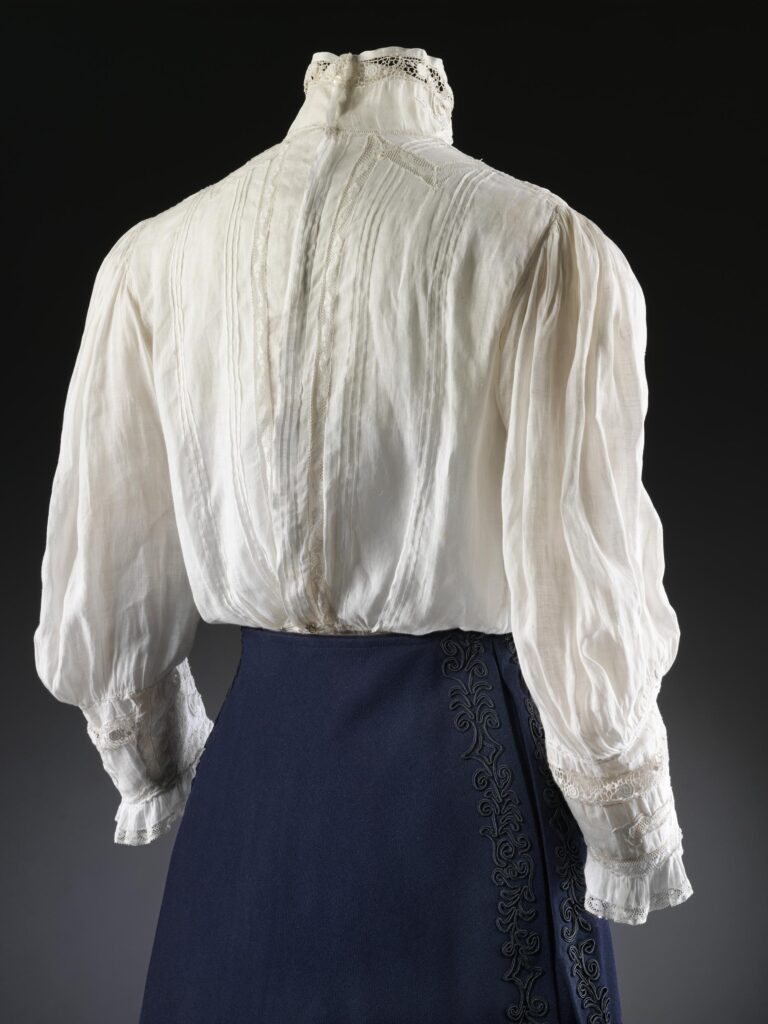The blouse, a fitted top-wear worn by women with sari or lehenga, is a staple in the living tradition of India’s dressing habits. A piece of clothing so obvious in the everyday clothing of Indian women, we have remained largely ignorant of the rich history of the blouse, a garment once unknown to the subcontinent. This exhibition documents the history of the blouse from its early inceptions to its gradual evolution over the years. The exhibition understands the history of the blouse through the intersection of the transition of not covering the upper body to covering the upper body and the transition from wearing unstitched clothes to stitched clothes.
Spanning over a temporal framework, from 1st century A.D. to mid twentieth century, the exhibition will highlight some key moments in history, bring forth the role of colonial and non colonial influence on woman’s clothing- with the intention of raising questions around ideas of ‘tradition’ vis-à-vis ‘modern.’ The archaeological relics, paintings, and photographs, woven together by the historical narrative will look at the blouse as a historical object, as a form of cultural identity, a marker of social status and as a statement on social and moral values which if more often than not, is associated with the woman’s body.
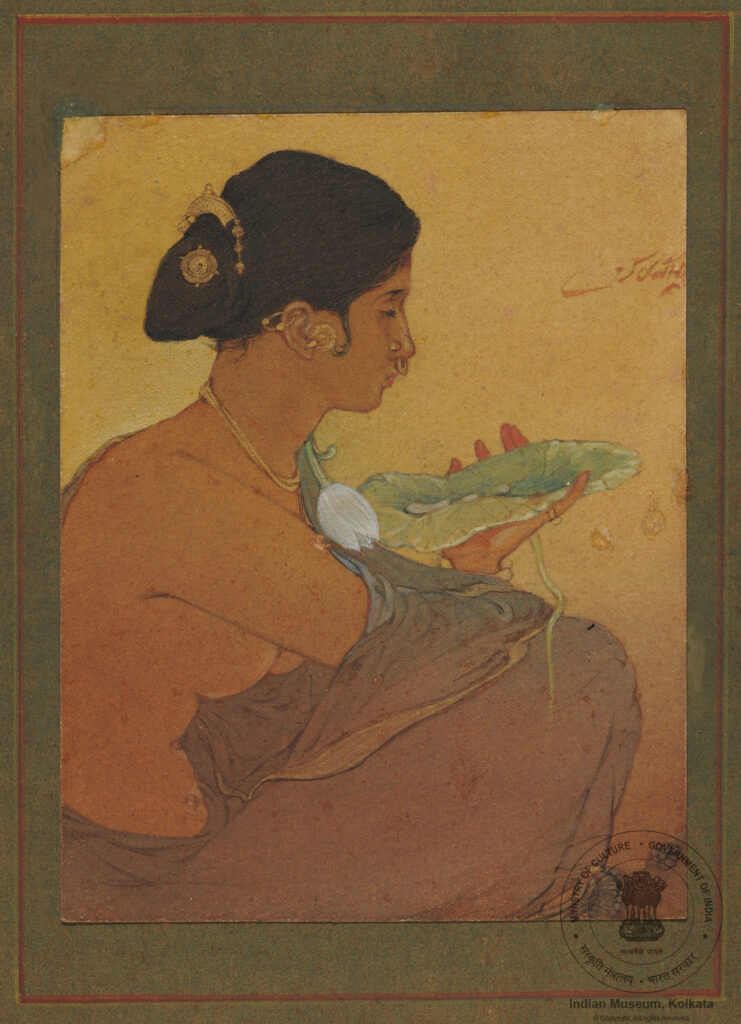
India
West Bengal, Kolkata
Painting of a woman
Abanindranath Tagore
Watercolour on paper
Indian Museum, Kolkata
AT-86-680
Drawing across from repositories of archaeological relics, paintings and photographs, this exhibition will take you through the four main sections- history of women’s clothing in India’s ancient past; cultural influences of various non-European foreign forces; colonialism, morality and its effect on clothing; sartorial changes and self-fashioning by the women of the elite families; fashioning and the future of the blouse and emergence of a syncretic style of clothing.
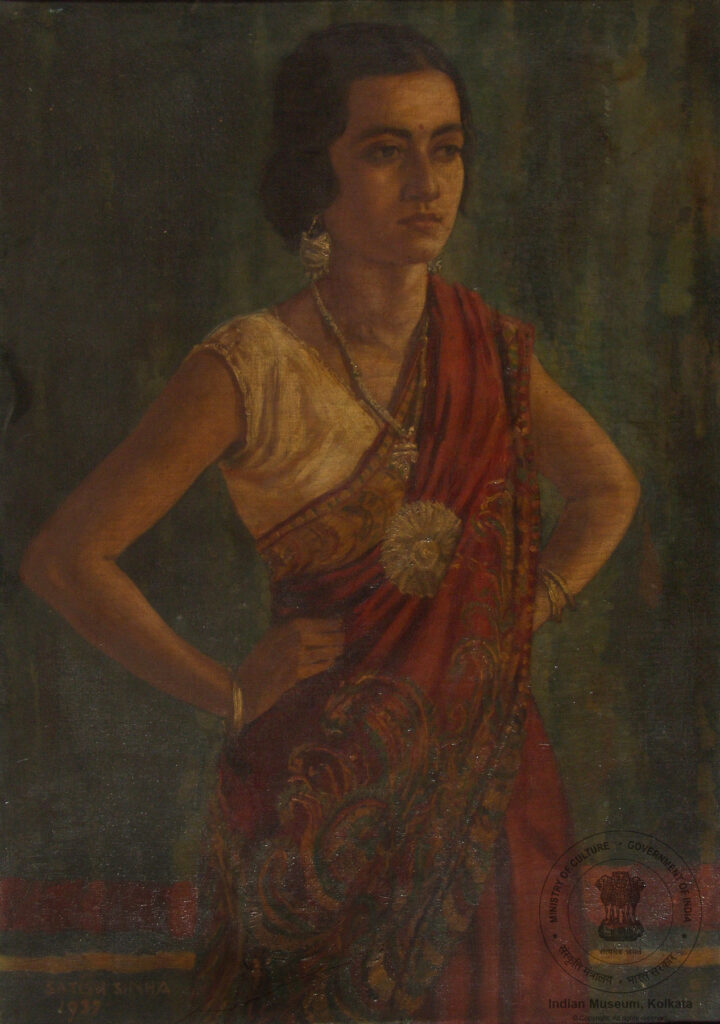
India
West Bengal, Kolkata
Painting of a Lady named Binadevi
Satish Chandra Sinha, 1937
Oil on canvas
89 x 63 cm
Indian Museum, Kolkata
AT/85/663
Through the history of the blouse, this visually stimulating exhibition hopes to bring to focus the history of an everyday object which proves crucial to the politics of identity, morality and culture inviting us to rethink the power of ordinary objects in our self fashioning and self expression.
Looking into the Ancient past
The climate of any geographical location is the key factor in determining the sartorial practices of the people of that region. Indian subcontinent and its tropical climate naturally gravitated its people to wear garments which made them to survive the extreme hot summers.
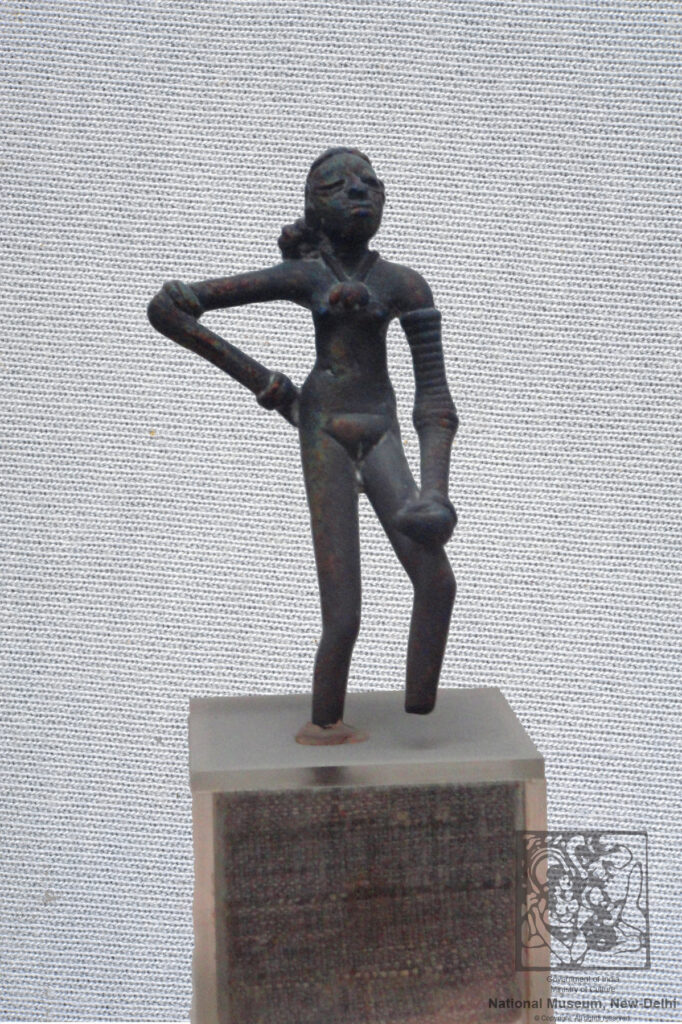
India
New Delhi
Dancing Girl, c.2500 B.C.
Bronze
10.5 x 5 x 2.5 cm
National Museum, New Delhi
Hr.5271/195
Textile being an extremely delicate object, it is rare that we find actual evidences of costumes and clothing from India’s ancient past. The tropical climate of the subcontinent makes it impossible for textiles to survive and the near absence of any costume makes it greatly difficult to study the history.
However several archeological, temple statuaries and similar objects help us to illustrate the ways women would dress themselves in drapes covering their lower body mostly, wearing unstitched lengths of woven fabric, varying from wrapping the upper body or covering the breasts partially, even keeping their upper body bare at times and using more of jewellery and other adornments.

India
New Delhi
Ganga, Gupta period, 5th – 6th Century
Terracotta
National Museum, New Delhi
L.2
Women wearing stitched choli– the predecessor of blouse- was a much later phenomenon which emerged across the subcontinent at different points. All the sculptures of yakshis, apsaras, goddesses we find on temple arches and amongst excavated relics show women leaving their upper bodies uncovered, with occasional waist bands or opulent jewellery covering them.

Darpanika
11th century
Khajuraho, Madhya Pradesh
Sandstone
Indian Museum, Kolkata
The elaborately and finely carved sculpture represents a female figure standing under a bower formed by a fig tree in which are seen squirrels and a bird. She is engaged at her toilet and holds in front of her face by her left hand a convex mirror while her right hand is raised over her head possibly arranging her hair. The intricate sculpted female instead have a necklace , a longer piece of neckwear covering her breasts partially. She covers her lower body with a drape-evident from the creases- a waistband and ornaments. . The female figure represents how keeping breasts uncovered seemed to be natural for women in ancient India.
Islamic dynasties and the change in women’s clothing
India has always been a land frequented by invaders from foreign land which brought many changes in the cultural milieu of the country. From 13th century with the rule of the Khaljis, the Tughlaqs, the Sayyids and the Lodis, there were nuanced and significant changes in sartorial styles.
The royal women of the courts wore long robe like jamas over a layer of under clothing. The islamic culture endorsed women to be completely covered.
“….the idea of nudity being sinful came with the Abrahamic religions.”
Bandana tewari, Fashion features editor, Vogue
But gradually with time, there was a gradual shift in the way women of the royal courts dressed. Along with the jama, tight fitting angias, along with sheer odhnis were introduced as part of the earlier layered ensemble.
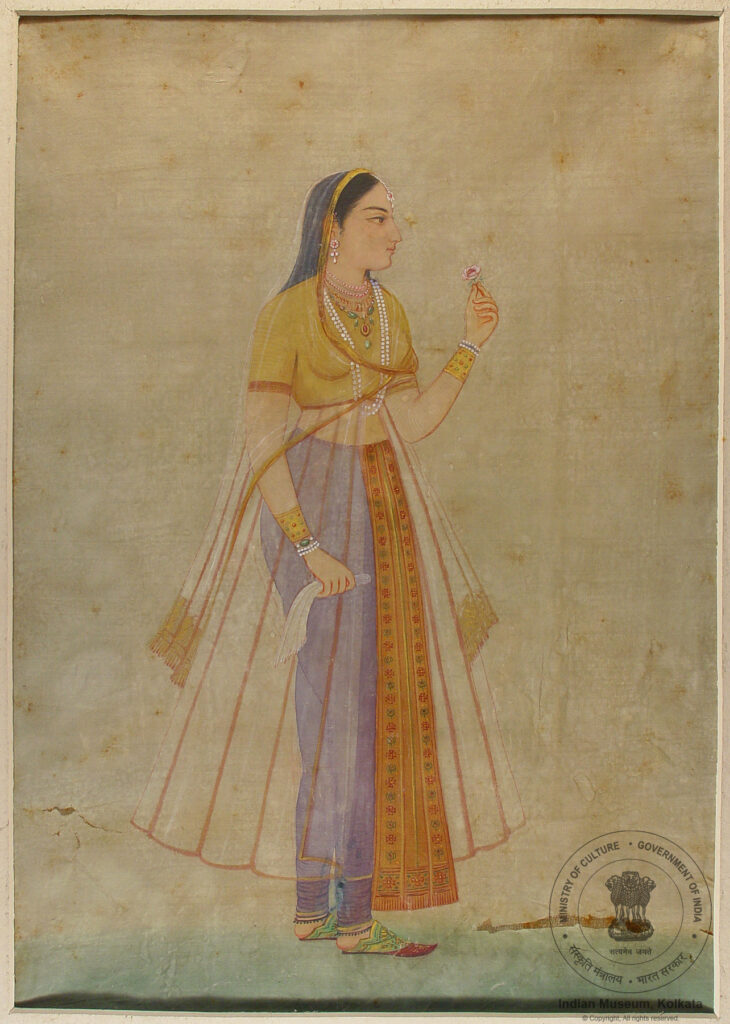
India
West Bengal, Kolkata
Portrait of Gul Shafa, 20th century
Iswari Prasad Varma
Watercolour on silk
66 x 50 cm
Indian Museum, Kolkata
R.14573
It was result of cross pollination between the conservative Islamic culture and the prevalent culture of the larger Indian subcontinent, where women still either left their upper body naked or lightly covered by breast bands or cholis , exposing the midriff.
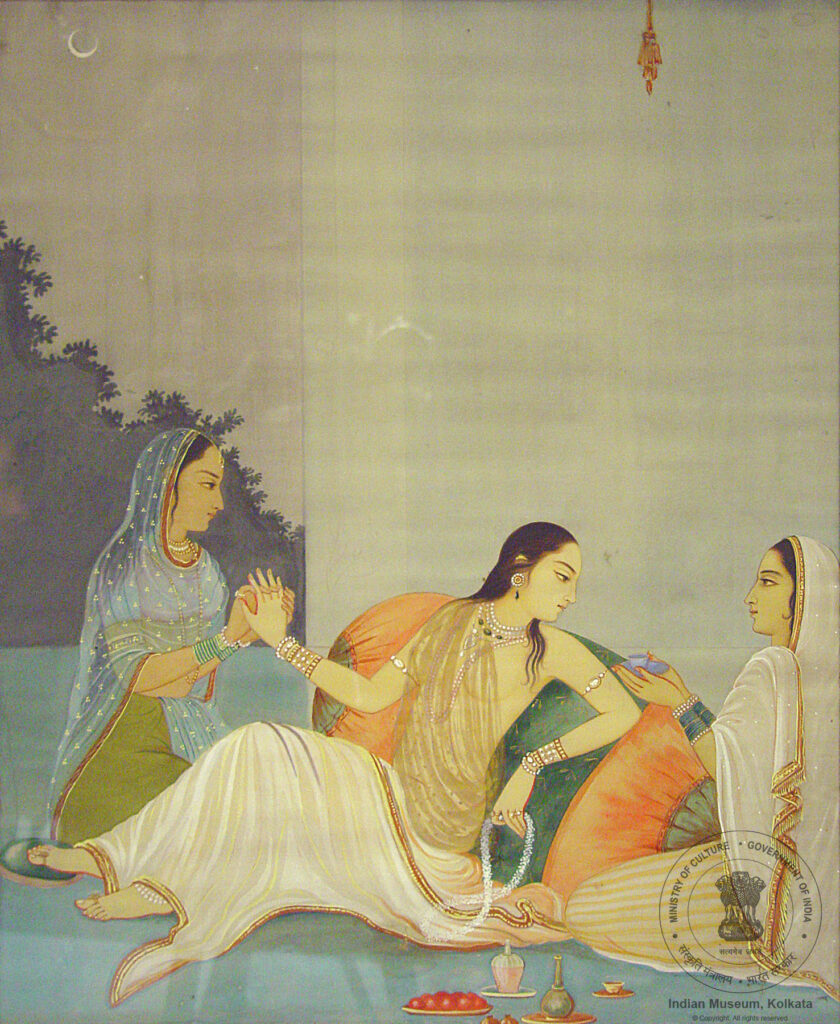
India
West Bengal, Kolkata
Ladies in a toilette, 20th century
Iswari Prasad Varma
Watercolour on silk
Indian Museum, Kolkata
R.14577
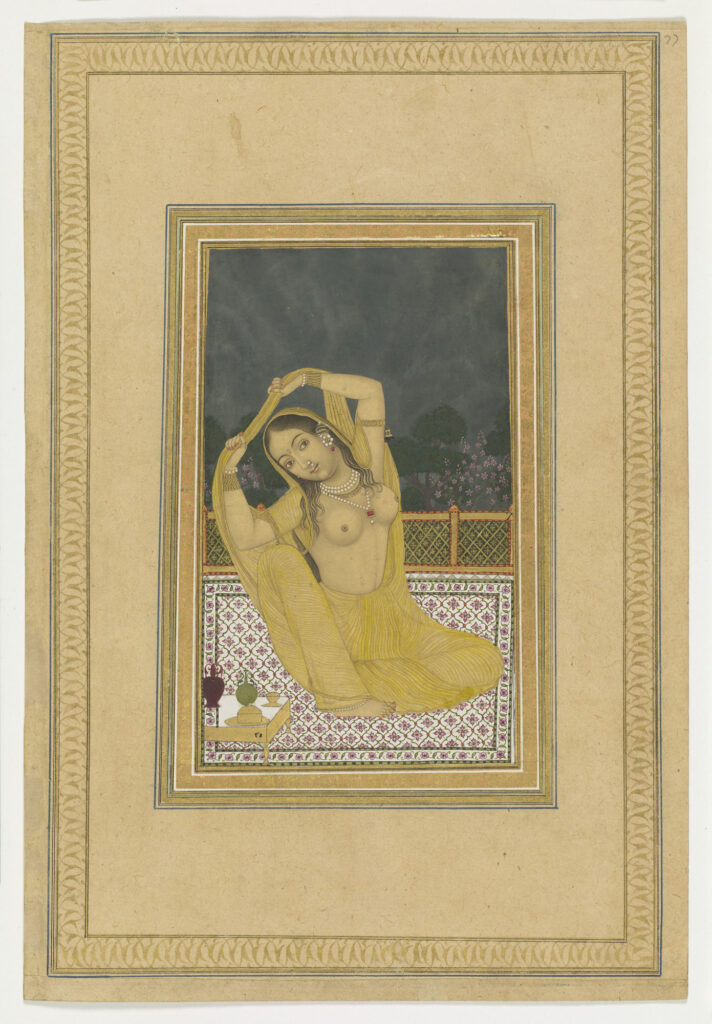
United Kingdom
England, London
Paintings of a Nayika waiting for her lover, late 18th century
Watercolour on paper
17.4 x 10.2 cm
Royal Collection Trust
RCIN 1005069 . aq
While the women of Muslim courts wore angias as part of their ensemble, the deccan courts and and women of western India during the in medieval period wore ghagras (long skirt) with cholis, which were highly embroidered.

India
West Bengal, Calcutta
Painting, 20th century
Watercolour on paper
71 x 44 cm
Indian Museum, Kolkata
R.14579
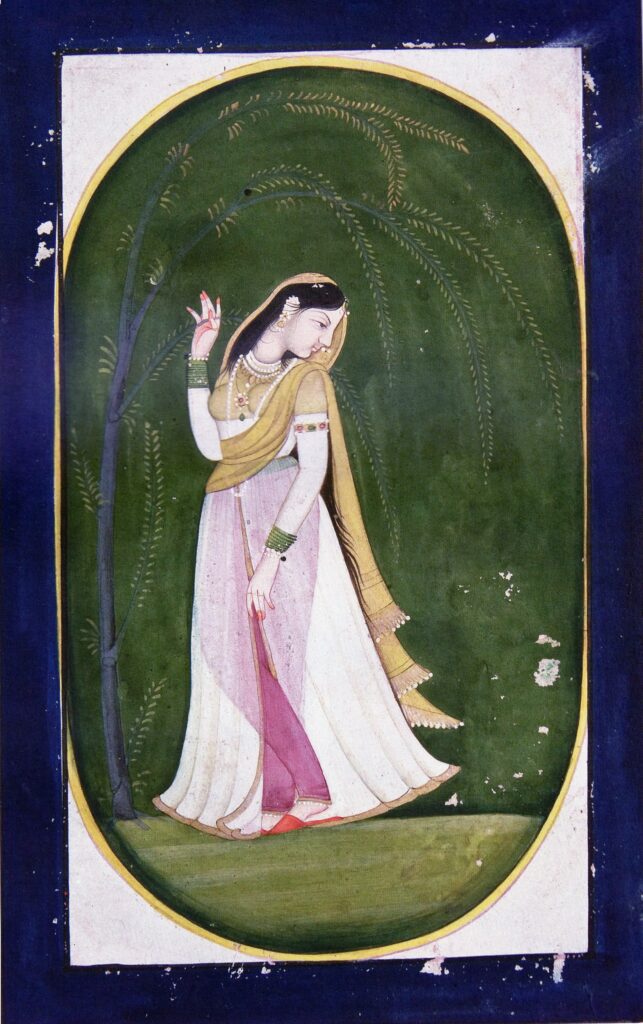
India
Gujarat, Surat
Abhisarika Nayika, c. 1820
Opaque pigments on paper
11.8 x 6.6 cm
TAPI Collection
A.99.20082
Over the centuries, with the advent of Mughal rule, a more varied culture appeared. Matrimonial alliances with Mughal rulers and Indian royal woman were common which reflected in their costumes. There was an assimilation of different cultures which made women to wear cholis/blouses while some women did not. It must be remembered here that choice of clothes, the matter of covering breasts, keeping body exposed also rested on social position of women and it was never a uniform emergence of style across India.
Colonising women and their sartorial choices
The colonial rule in India , especially the britishers who ruled in India over centuries, had contributed significantly in introducing new forms of dressing, that was previously unknown to the men and women of this country.
Infact the words, ‘petticoat’, ‘blouse’ which we use so often to describe a traditional Indian ensemble, are ideas which are foregin.
From common women to even women of royalty, covering breasts or wearing of fitted garments was not a uniform or standard practice.

India
West Bengal, Kolkata
Woman seated on floor, preparing pān (betel leaf), 19th century
Kalighat painting
38.1×28.5cm
Gifted to Victoria Memorial Hall, Kolkata by Mr. Anjan Roy
We find ample examples of women in paintings, photographs to suggest that wearing loose drapes to cover bare minimum was encouraged in the Indian society. Also fitted tight clothes was not conducive to wear in the hot tropical climate of the country.

India
Calicut, Kerala
A Nair lady, Malabar, c.1905
Postcard
13.80 x 8.90cm
Private collection, Omar Khan
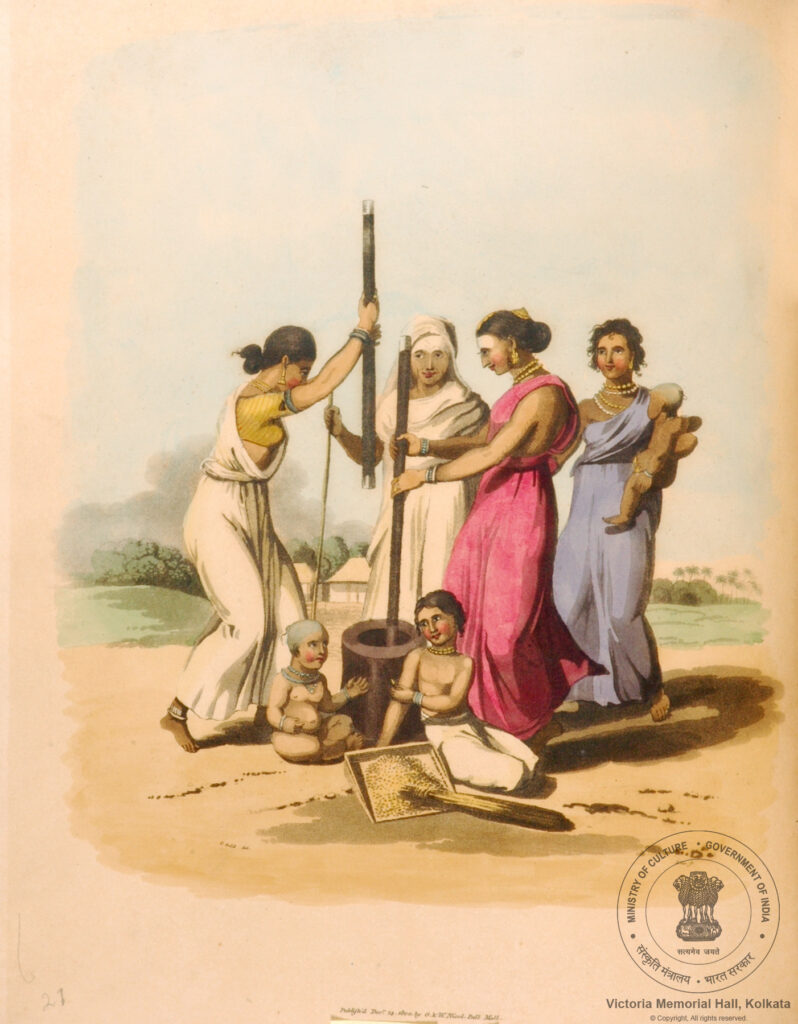
Gentoo woman employed in beating Rice
1806
India
Coloured aquatint
Gift of Mrs. George Lyell to Victoria Memorial Hall, Kolkata
This painting, categorised as Oriental Drawings is a collection of images produced from sketches made by Captain Charles Gold in India between 1791 and 1798 while he was serving in military campaigns against the ruler of the Kingdom of Mysore, Tipu Sultan. The book was designed to appeal to contemporary taste for the ‘exotic’, and was dedicated to the war- time Governor General of India, Charles, Marquis Cornwallis (1738- 1805). From a series of 50 Coloured Engravings entitled “Oriental Drawings” sketched between 1791 & 1798, Published by G. & W. Nicoll, London. This painting shows a group of Indian women at work, beating rice to remove husk. This is depicts how common women would dress in their regular life. We can see here how the four women are wearing unstitched drapes – something similar to that of a saree -covering their torso and lower body. But not everyone is wearing it with blouse or any other upper body garment. One of them is wearing what seems to be like an interpretation of a blouse, the woman in white, however has completely covered herself in the drape, including her head. The other two women can be seen are wearing saree without blouses.
Introduction of a new dress code: the saree – blouse
By 19th century, there was a new emerging socio cultural ethos. There were important reforms brought to empower women and improve their position in the society. Discussions around abolition of kulin practices of polygamy, campaign for widow remarriage, encouraging women to educate themselves occupied the minds of Indians. Consequently, women started coming out of their inner quarters and became more visible in the public spaces.
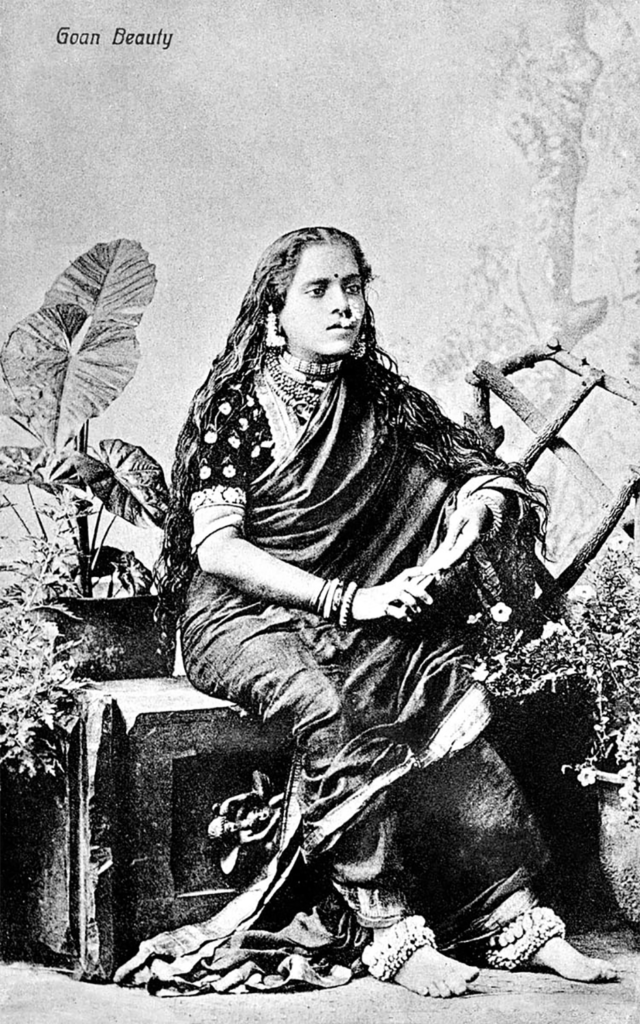
India
A Goan Beauty, c. 1908
Postcard
13.85 x 8.90cm
Private collection, Omar Khan
This created a discomfort in the victorian sensibilities of the colonial society. Traditionally, sarees were worn without blouses or petticoats. This would mean a that there was substantial part of women’s body remained, uncovered and exposed.
The Indians who spearheaded the reform movements, were also concerned how to dress their women “appropriately”. Nudity was looked down upon as something backward and immoral by the westernised society. Naturally it was sought to be of utmost importance to reform the way women would dress.

Jnanadanandini Devi, early 20th century
Photograph
Courtesy Wikicommons
The woman, who single handedly brought about the change and introduced a new dress code for women, was Jnanadanandini Devi. Married to Satyendranath Tagore, the first Indian to join Indian Civil Services) Jnanadanandini travelled to western india with her husband. It is noted that during one occasion, Jnanadanandini was refused entry to a club since she was not “appropriately dressed.” Her travels and public life made her to bring significant sartorial reforms.

Jnanadanandini Devi, Satyendranath tagore, Kadambari Devi and Jyotirindranath Tagore, 1867
Photograph
Courtesy Wikicommons
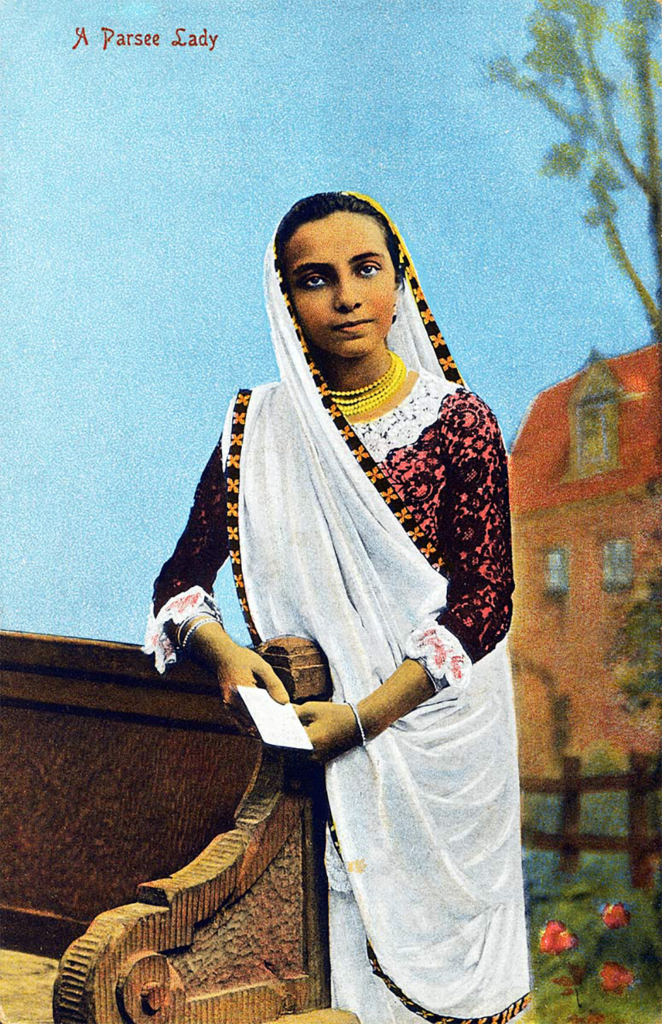
India
A Parsee Lady, c. 1903
Postcard
13.80 x 8.80cm
Private collection, Omar Khan
Being highly influenced by the Parsee women and the newly introduced Parsi gara when she went to Western India, Jnanadanandini draped her saree with pleats tucked in middle and the longer loose end-palla- drawn across to cover the breasts and flowing down from the left shoulder.
This style of saree draping came to be known as Nivi, from the bengali word navin, meaning new.
But this new reformed way of wearing a saree meant women had to introduce petticoat and blouse as part of their everyday wear.
Front and back details of a Blouse
c. 1908
Great Britain
Embroidered lawn, machine-made lace insertions,
mother-of-pearl
Victoria & Albert Museum, T.59-1960
High-necked blouse of fine white lawn with full gathered elbow-length sleeves and a high band collar. Bands of machine-made lace insertion
trim the front yoke, collar and sleeves, and floral trails of embroidered insertion in white curve the shoulder to the waist. Small mother-of-pearl
buttons (several missing) fasten the blouse at the centre back. Two wire stiffeners in the collar. This blouse was typically worn by women in Edwardian England. Highly influenced by Edwardian fashion, the blouse gradually mutated itself and took inspirations from western shirts and corsets and blouses.Once the blouse was introduced along with the new drape of saree, women in India, modelled their blouse on these high collared, frilled neckline and voluminous sleeves.
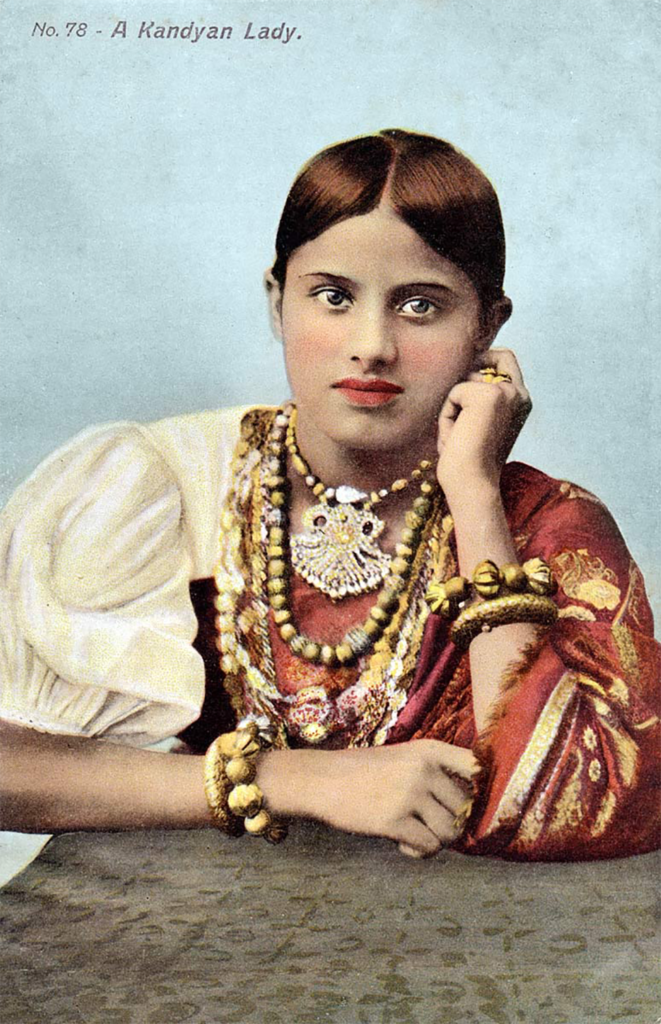
India
A Kandyan Lady, c.1910
Postcard
Private collection, Omar Khan
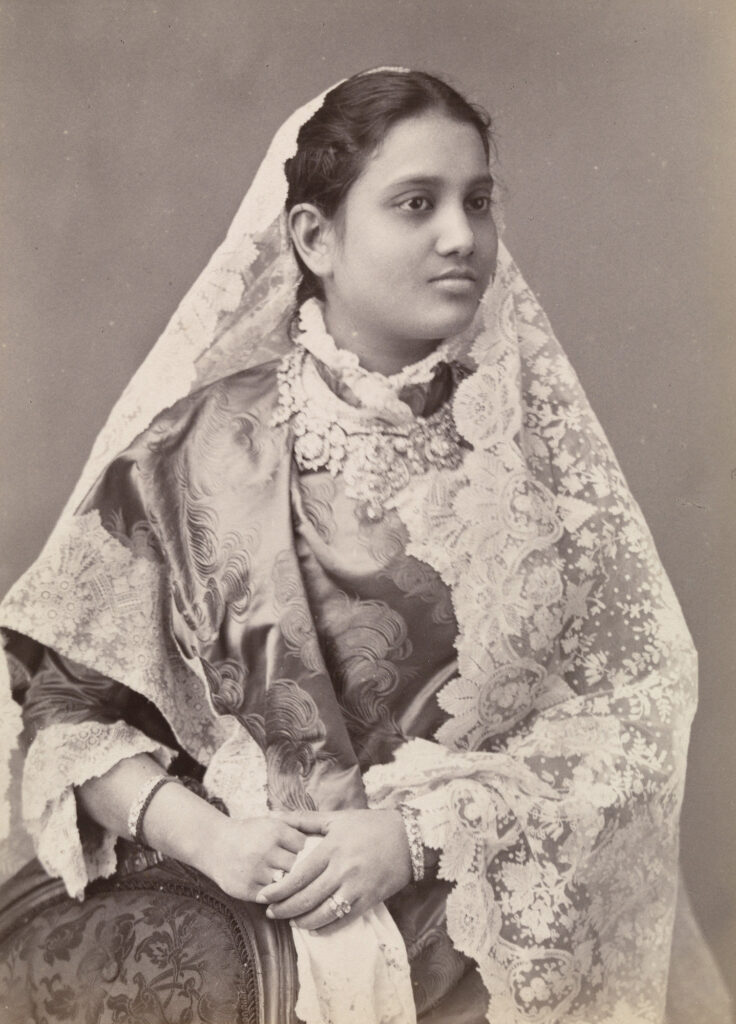
Portrait of Suniti Devi, Maharani of Cooch Behar
1887
United Kingdom
Photograph, Albumen print
Royal Collection Trust, RCIN 2107612
Suniti Devi in this half length portrait faces three-quarters to the right and wears a lace headdress that extends to her waist and a diamond necklace and matching bangles. She rests her left arm on the back of a chair. Apart from being the Maharani she was the daughter of Brahmo reformer Keshab ChAndra Sen. Her, full sleeves blouse with lace frills, the high neckline, the intricate lace drape covering the head shows a confluence of the western influences and her reformist brahmo background.
Women started wearing elaborate undergarments or bodice underneath blouses. Blouses had high collars, frills, ribbons and brooches. Even saree was often draped by women of elite families to emulate the flow and drape of a western gown.
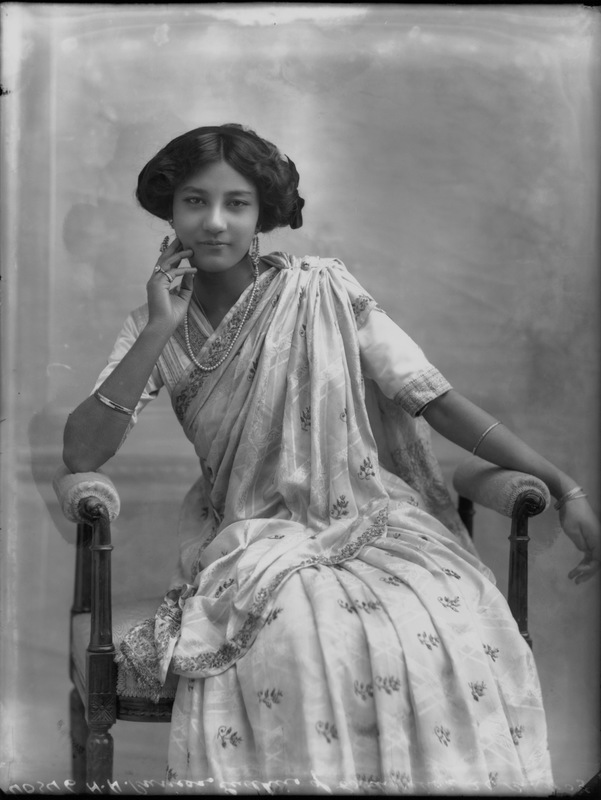
United Kingdom
England, London
Princess Sudhira of Cooch Behar, 1910
Whole-plate glass negative
National Portrait Gallery
NPG x33307
While women of elite and royal families were quick to take inspiration from the western influences, women who had a substantial public life as performers and musicians too adapted themselves as ways of self fashioning to cater to the changing taste of the new public.
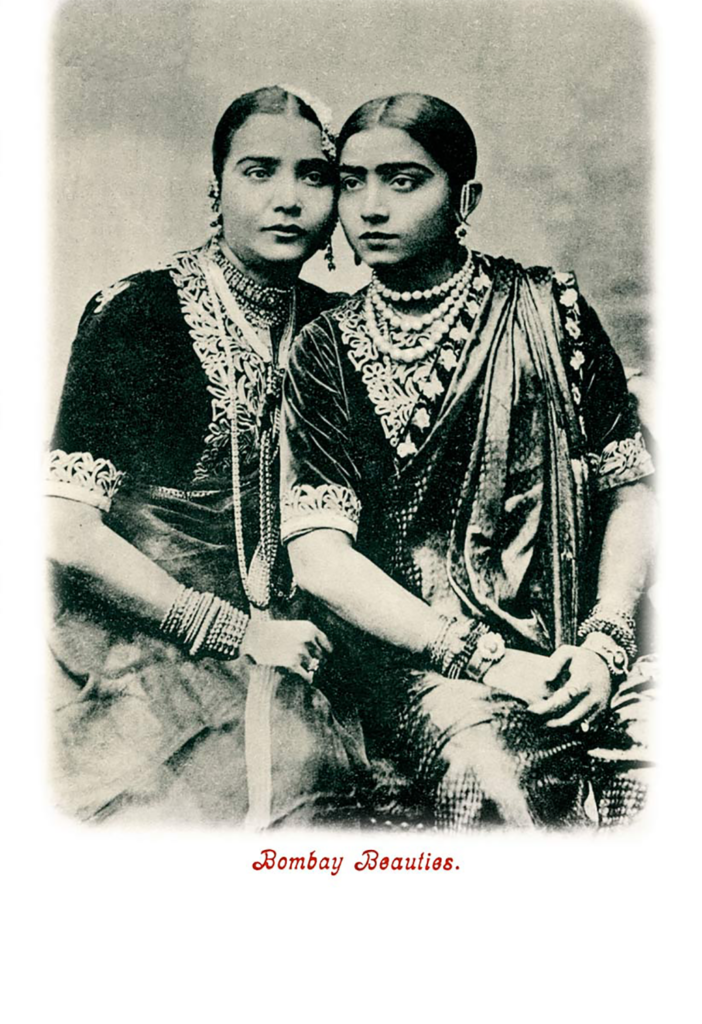
India
Bombay Beauties, c.1905
Postcard
Private Collection, Omar Khan
Singer performer Gauhar Jaan born as Angelina Yeoward (1873-1930) became one of the most famous singers in India, and one of its first gramophone-recorded artists. Her records were among the most popular between 1910 and 1920. She was also a postcard phenomenon where she was seen wearing sarees and elaborate blouses with heavily embroidered necklines, and exaggerated sleeves with frills and ribbons which were represented an amalgamation of different styles from the west and India.
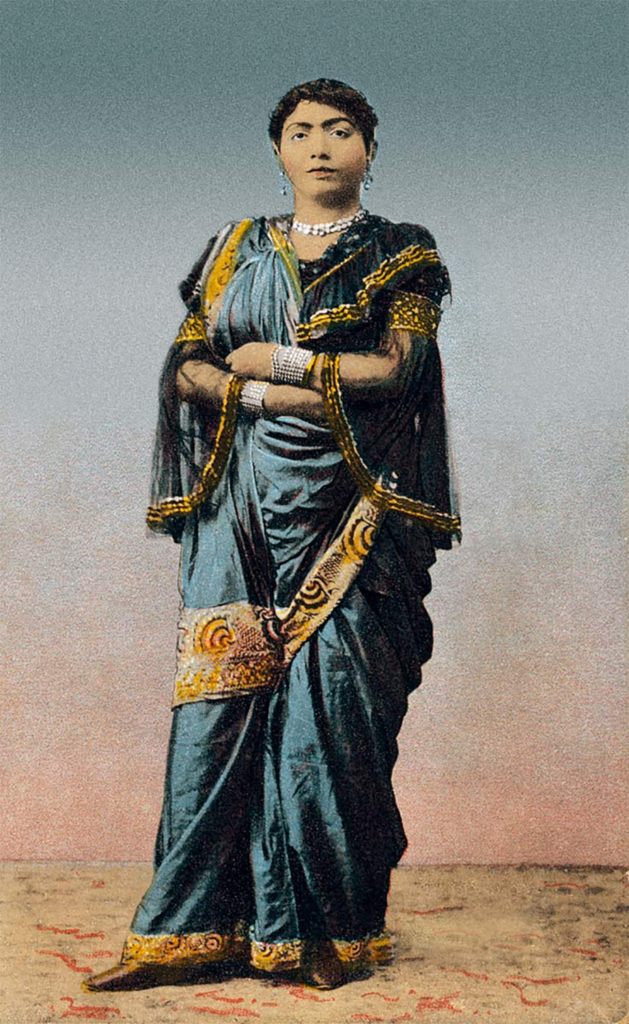
India
Gohar Jan, c.1910
Postcard
Private Collection, Omar Khan
13.80 x 8.65cm
Epilogue
We traversed through centuries, from women not covering their breasts to covering them and to make them fitted into garments, it is a long history replete with changing political climate, cultural differences. But what remains central to all these changing stories, is the question of how women’s body has been at the centre of contentious debates since ages. It also opens up what constitutes modern and tradition. The question of nudity and censorship that is so rampant in our contemporary time, probably needs to be revisited and answered and this exhibition might be one such example to address these questions.
Credit & Acknowledgements
- Ms. Shilpa Shah and Mr. Praful Shah
- Weavers Studio Resource Centre
- Victoria Memorial Hall
- Indian Museum
- Royal Collection Trust
- National Portrait Gallery
- Paper Jewels Postcards from the Raj
- The Marg Foundation
- Ms. Kavita Patel
- Ms. Namrata Ghosh
- Ms. Ritwika Misra
References
Online Digital Repositories
- Victoria Memorial Hall
- Indian Museum
- Royal Collection Trust
- National Portrait Gallery
- Paper Jewels Postcards from the Raj
Books
- Karlekar, Malavika. ” Reform and Sartorial Styles in 19th century Bengal” , in Framing Women: Gender in the Colonial Archive, Marg, vol 62, number 3, (June 2011): 66 – 71
- Kumar, Ritu. Costumes and Textiles of Royal India. London: Christie’s Books Limited, 1999.
- Losty, J.P. Court & Courtship: Indian Miniatures in the TAPI Collection. New Delhi: Niyogi Books, 2020
- Pathak, Anamika. Indian Costumes. New Delhi: Roli Books, 2006.
Useful Resources
- Thakur Barir Shaaj Poshaak (Sartorial choices of the Tagore Family) – A performance conceptualised by Dr. Reba Som, 2012
- Arti Sandhu, Indian Fashion: Tradition, Innovation, Style (Bloomsbury, 2014)
- Textile Treasures: Shawls and Sarees: a virtual exhibition on Google Arts & Culture.
- Maharanis: Women of Royal India- A century of photographic and social history.
